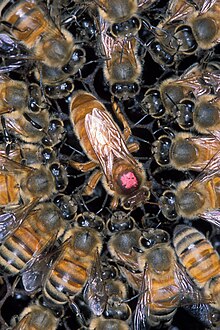蜂后
蜂后又稱蜂王、女王蜂,是蜜蜂群體中唯一能正常產卵的雌性蜂,蜂后通常是蜂群中其它成员的母親,因此也稱之为母蜂。一个蜜蜂群體中可能有幾千到幾萬隻蜜蜂,但只會有一隻蜂后。除了产卵, 蜂后的各种腺体还会释放不同的信息素,调节工蜂的行为和生理,维持蜂群的稳定[1]。

特征和生命周期
编辑蜂后會從蜂王台中出生,預計成為蜂后的幼蟲會持續食用蜂王漿直到發育完成,未持續食用蜂王漿的雌性幼蟲會成為工蜂。蜂后的寿命一般约26个月[2],但2010年代以来大部分蜂后的寿命不到一年[3]。蜂后一生都依赖于食用蜂王浆来延长寿命。
從卵發育成蜂后羽化需要的時間依蜜蜂的品種而不同,東方蜜蜂需要15天,西方蜜蜂需要16天,而西方蜜蜂的亞種東非蜂需15天。
先羽化的新蜂后會尋找尚未羽化的蜂后並摧毀潛在的競爭者,若多隻新蜂后同時羽化,新蜂后之間將展開激烈的廝殺,最后只会留下一只新蜂后。
交尾与繁殖
编辑蜂后羽化后大约7~10天交尾,交尾后2~3天开始产卵。處女蜂后是指未发育完成、未达到交尾期而还未交尾的蜂后;或指错过交尾时刻的蜂后,后者由于未能受精,只能以孤雌生殖产下雄蜂。
即使成功受精,若然粮食短缺,工蜂会减少对蜂后的喂食,导致蜂后无法或减少产下后代。
处女蜂王在空中与多头雄蜂(平均12只[4])交尾,获取的精子储存在受精囊中供其一生产卵使用[5]。蜂后的一雌多雄交尾方式增加了蜂群内后代工蜂的遗传多样性[6],提高了蜂群的抗病能力和适应度[7][8][9]。
蜂后的有效交尾频率对蜂群的发展具有重要影响,充分的交尾频率(有效交尾频率高于7)有助于蜂群的稳定发展和提高生产能力[2]。
長久只能產下雄蜂的處女蜂后,最終很可能被工蜂推翻,以新蜂后作替換;或是如果工蜂無法造出新蜂后,雄蜂增多,又缺少新工蜂填補,最終導致蜂群滅亡。
病虫害
编辑蜜蜂作为多种病原体的宿主,容易受到各种病虫害的影响,而蜂王也不例外。主要的病虫害包括蜂螨、微孢子虫以及多种病毒。[2]
最为严重的蜜蜂病虫害之一是狄斯瓦螨(Varroa destructor)[10]。武氏蜂盾螨(Acarapis woodi)在蜂王中的寄生也较为普遍[11],感染会导致蜂王体重下降,受精囊内储存的精子数量减少[12]。
感染蜜蜂的微孢子虫有蜜蜂微孢子虫(Nosema apis)和东方蜜蜂微孢子虫(Nosema ceranae)[13],这两种微孢子虫均可感染蜂王,并导致组织损伤[14][15]。感染蜂王后,其卵母细胞表面形态发生改变,内部卵黄颗粒分解,部分线粒体退化,同时肠上皮细胞增生、围食膜退化,进而导致蜂王产下的卵中有大比例的卵不能孵化[16]。
已经鉴定出超过30种蜜蜂病毒,其中中已在蜂王体内检测到的病毒包括残翅病毒(Deformed wing virus)、狄斯瓦螨病毒-1(Varroa destructor virus-1)、类瓦螨病毒(Varroa destructor Macula-like virus)、慢性麻痹病毒(Slow bee paralysis virus)、黑蜂王台病毒(Black queen cell virus)、蜜蜂慢性麻痹病毒(Chronic bee paralysis virus)、蜜蜂急性麻痹病毒(Acute bee paralysis virus)、以色列急性麻痹病毒(Israeli acute paralysis virus)、囊状幼虫病毒(Sacbrood virus)以及克什米尔蜜蜂病毒(Kashmir bee virus)等[2]。蜂王感染病毒通常不会出现明显症状[17],但某些病毒感染,如残翅病毒可能导致蜂王翅膀畸形[18]。
参考文献
编辑- ^ Slessor, KN; Winston, ML; Le Conte, Y. Pheromone communication in the honeybee (Apis mellifera L.).. Journal of chemical ecology. 2005-11, 31 (11): 2731–45. PMID 16273438. doi:10.1007/s10886-005-7623-9.
- ^ 2.0 2.1 2.2 2.3 杜瀚超; 袁春颖,丁桂玲. 蜜蜂蜂王质量及其性状表现影响因素研究进展. 环境昆虫学报. 2023, 45 (1): 30–41 [2024-02-25]. (原始内容存档于2024-02-25).
- ^ Tarpy, David R.; vanEngelsdorp, Dennis; Pettis, Jeffrey S. Genetic diversity affects colony survivorship in commercial honey bee colonies. Naturwissenschaften. 2013-08, 100 (8): 723–728. doi:10.1007/s00114-013-1065-y.
- ^ Tarpy, D. R.; Nielsen, R.; Nielsen, D. I. A scientific note on the revised estimates of effective paternity frequency in Apis. Insectes Sociaux. 2004-05-01, 51 (2): 203–204. doi:10.1007/s00040-004-0734-4.
- ^ Boomsma, JJ; Baer, B; Heinze, J. The evolution of male traits in social insects.. Annual review of entomology. 2005, 50: 395–420. PMID 15822204. doi:10.1146/annurev.ento.50.071803.130416.
- ^ Palmer, Kellie A.; Oldroyd, Benjamin P. Evolution of multiple mating in the genus Apis. Apidologie. 2000-03, 31 (2): 235–248. doi:10.1051/apido:2000119.
- ^ Seeley, TD; Tarpy, DR. Queen promiscuity lowers disease within honeybee colonies.. Proceedings. Biological sciences. 2007-01-07, 274 (1606): 67–72. PMID 17015336. doi:10.1098/rspb.2006.3702.
- ^ Mattila, HR; Seeley, TD. Genetic diversity in honey bee colonies enhances productivity and fitness.. Science (New York, N.Y.). 2007-07-20, 317 (5836): 362–4. PMID 17641199. doi:10.1126/science.1143046.
- ^ Ding, G; Xu, H; Oldroyd, BP; Gloag, RS. Extreme polyandry aids the establishment of invasive populations of a social insect.. Heredity. 2017-11, 119 (5): 381–387. PMID 28832579. doi:10.1038/hdy.2017.49.
- ^ Calderone, Nicholas W.; Lin, Sisi; Kuenen, Lodewyk P.S. Differential infestation of honey bee, Apis mellifera , worker and queen brood by the parasitic mite Varroa destructor. Apidologie. 2002-07, 33 (4): 389–398. doi:10.1051/apido:2002024.
- ^ Pettis, J. S.; Dietz, A.; Eischen, F. A. Incidence rates of Acarapis woodi (Rennie) in queen honey bees of various ages. Apidologie. 1989, 20 (1): 69–75. doi:10.1051/apido:19890107.
- ^ Camazine; et al. How Healthy are Commercially-produced U.S. Honey Bee Queens?. American Bee Journal. 1998, 138 (9): 677–680.
- ^ Fries, Ingemar; Chauzat, Marie-Pierre; Chen, Yan-Ping; Doublet, Vincent; Genersch, Elke; Gisder, Sebastian; Higes, Mariano; McMahon, Dino P; Martín-Hernández, Raquel; Natsopoulou, Myrsini; Paxton, Robert J; Tanner, Gina; Webster, Thomas C; Williams, Geoffrey R. Standard methods for Nosema research. Journal of Apicultural Research. 2013-01, 52 (1): 1–28. doi:10.3896/IBRA.1.52.1.14.
- ^ Loskotova, J.; Peroutka, M.; Vesely, V. NOSEMA DISEASE OF HONEYBEE QUEENS (APIS MELLIFICA L.). Apidologie. 1980, 11 (2): 153–161. doi:10.1051/apido:19800205.
- ^ Traver, Brenna E.; Fell, Richard D. Low natural levels of Nosema ceranae in Apis mellifera queens. Journal of Invertebrate Pathology. 2012-07, 110 (3): 408–410. doi:10.1016/j.jip.2012.04.001.
- ^ Hassanein, M. H. Studies on the Effect of Infection with Nosema apis on the Physiology of the Queen Honey-bee. Journal of Cell Science. 1951-06-01, S3–92 (18): 225–231. doi:10.1242/jcs.s3-92.18.225.
- ^ Amiri, E; Strand, MK; Tarpy, DR; Rueppell, O. Honey Bee Queens and Virus Infections.. Viruses. 2020-03-17, 12 (3). PMID 32192060. doi:10.3390/v12030322.
- ^ Williams, GR; Rogers, RE; Kalkstein, AL; Taylor, BA; Shutler, D; Ostiguy, N. Deformed wing virus in western honey bees (Apis mellifera) from Atlantic Canada and the first description of an overtly-infected emerging queen.. Journal of invertebrate pathology. 2009-04, 101 (1): 77–9. PMID 19373971. doi:10.1016/j.jip.2009.01.004.